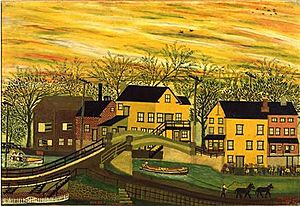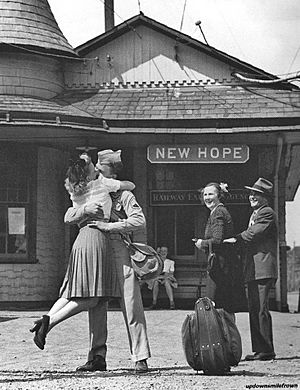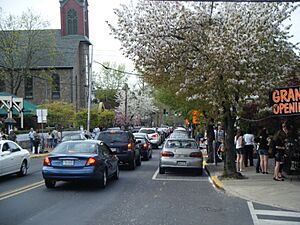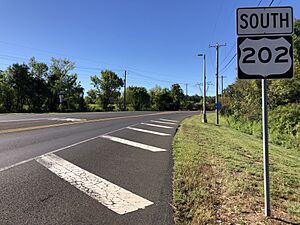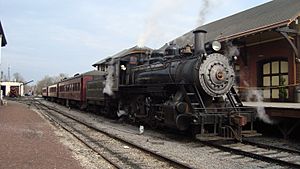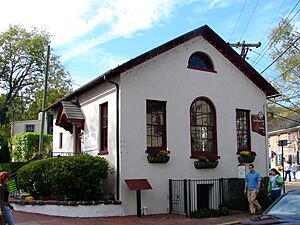New Hope, Pennsylvania facts for kids
Quick facts for kids
New Hope, Pennsylvania
|
||
|---|---|---|
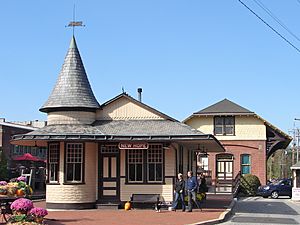
New Hope station in October 2010
|
||
|
||
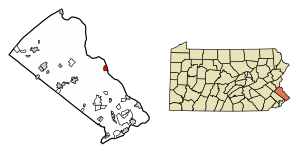
Location of New Hope in Bucks County, Pennsylvania (left) and of Bucks County in Pennsylvania (right)
|
||
| Country | United States | |
| State | Pennsylvania | |
| County | Bucks | |
| Area | ||
| • Total | 1.42 sq mi (3.67 km2) | |
| • Land | 1.27 sq mi (3.29 km2) | |
| • Water | 0.15 sq mi (0.38 km2) | |
| Elevation | 69 ft (21 m) | |
| Population
(2020)
|
||
| • Total | 2,612 | |
| • Density | 2,056.69/sq mi (794.08/km2) | |
| Time zone | UTC−05:00 (Eastern (EST)) | |
| • Summer (DST) | UTC−04:00 (EDT) | |
| ZIP Code |
18938
|
|
| Area codes | 215, 267, and 445 | |
| FIPS code | 42-53712 | |
| GNIS feature ID | 1182332 | |
New Hope is a small town, called a borough, in Bucks County, Pennsylvania, United States. In 2020, about 2,612 people lived there. New Hope is located about 30 miles (48 km) north of Philadelphia. It sits on the west bank of the Delaware River.
New Hope is known for its tourism. Many famous people have lived here, including Founding Father Aaron Burr and author James A. Michener.
Contents
History of New Hope
Early Days: The 1700s
New Hope is on the Old York Road. This was once the main road between Philadelphia and New York City. It was seen as the halfway point. Travelers would stay overnight and cross the Delaware River by ferry the next morning. Today, part of U.S. Route 202 is still called York Road.
The town was first named "Coryell's Ferry." This was after the person who owned the ferry business. The name "New Hope" came after a big fire in 1790. Several mills were destroyed. Rebuilding them gave people "new hope."
Before George Washington's crossing of the Delaware River, Washington stayed in New Hope. He then destroyed the ferry so the British Army could not follow him. After the Battle of Trenton and Battle of Princeton, British troops shelled the town. They thought the town supported the American army. Some old buildings still have signs of British cannonballs.
Railroads and Growth: The 1800s and 1900s
The North Pennsylvania Railroad built a line to New Hope in 1891. The Reading Railroad later took it over. Passenger train service to Philadelphia stopped in 1952.
From 1952 to 1966, only freight trains came to New Hope. They brought paper and sand. In 1966, the New Hope and Ivyland Railroad started. It bought 16 miles (26 km) of track. Scenic train rides for tourists began that same year. The New Hope and Ivyland Railroad still offers fun tourist train rides today.
Recent Times: The 2000s
In 2004 and 2006, New Hope had floods when the Delaware River overflowed. Luckily, the town's businesses were able to reopen quickly. These floods were not as bad as the Great Flood of 1955.
Geography and Climate

New Hope covers about 1.4 square miles (3.6 km2). Most of this area is land, but 0.2 square miles (0.5 km2) is water. A lot of this water is the Delaware River.
The town is where the Delaware River meets Aquetong Creek. This creek starts in nearby Solebury Township. The name Aquetong comes from a Native American word. It means "spring in the bushes." Near New Hope, the creek forms a pretty pond and waterfall. This is near the Bucks County Playhouse, which used to be a mill.
Weather in New Hope
New Hope has a humid continental climate. This means it has warm, humid summers and cold winters. The hottest temperature recorded was 103.3°F (39.6°C) in July 2011. The coldest was -12.1°F (-24.5°C) in January 1984.
The town gets about 48.68 inches (123.6 cm) of rain each year. July is usually the wettest month. Snowfall from November to April is about 24 to 30 inches (61 to 76 cm). Big snowstorms happen every few years.
| Climate data for New Hope, Elevation 151 ft (46 m), 1981-2010 normals, extremes 1981-2018 | |||||||||||||
|---|---|---|---|---|---|---|---|---|---|---|---|---|---|
| Month | Jan | Feb | Mar | Apr | May | Jun | Jul | Aug | Sep | Oct | Nov | Dec | Year |
| Record high °F (°C) | 71.5 (21.9) |
78.3 (25.7) |
87.7 (30.9) |
94.4 (34.7) |
94.9 (34.9) |
96.9 (36.1) |
103.3 (39.6) |
100.5 (38.1) |
98.2 (36.8) |
89.9 (32.2) |
81.1 (27.3) |
75.2 (24.0) |
103.3 (39.6) |
| Mean daily maximum °F (°C) | 39.6 (4.2) |
43.1 (6.2) |
51.4 (10.8) |
63.3 (17.4) |
73.3 (22.9) |
82.2 (27.9) |
86.5 (30.3) |
84.8 (29.3) |
77.8 (25.4) |
66.4 (19.1) |
55.3 (12.9) |
44.0 (6.7) |
64.1 (17.8) |
| Daily mean °F (°C) | 30.9 (−0.6) |
33.8 (1.0) |
41.3 (5.2) |
51.9 (11.1) |
61.6 (16.4) |
70.9 (21.6) |
75.6 (24.2) |
73.9 (23.3) |
66.7 (19.3) |
55.0 (12.8) |
45.4 (7.4) |
35.6 (2.0) |
53.6 (12.0) |
| Mean daily minimum °F (°C) | 22.2 (−5.4) |
24.4 (−4.2) |
31.1 (−0.5) |
40.4 (4.7) |
49.8 (9.9) |
59.6 (15.3) |
64.6 (18.1) |
63.1 (17.3) |
55.5 (13.1) |
43.6 (6.4) |
35.6 (2.0) |
27.1 (−2.7) |
43.2 (6.2) |
| Record low °F (°C) | −13.0 (−25.0) |
−4.0 (−20.0) |
1.5 (−16.9) |
17.5 (−8.1) |
32.4 (0.2) |
40.7 (4.8) |
46.9 (8.3) |
41.5 (5.3) |
32.8 (0.4) |
24.2 (−4.3) |
11.0 (−11.7) |
−1.2 (−18.4) |
−13.0 (−25.0) |
| Average precipitation inches (mm) | 3.47 (88) |
2.75 (70) |
4.13 (105) |
4.08 (104) |
4.24 (108) |
4.52 (115) |
5.15 (131) |
4.01 (102) |
4.40 (112) |
4.03 (102) |
3.76 (96) |
4.14 (105) |
48.68 (1,236) |
| Average relative humidity (%) | 65.8 | 62.1 | 57.9 | 57.1 | 61.9 | 66.5 | 66.4 | 69.0 | 70.0 | 69.0 | 67.6 | 67.5 | 65.1 |
| Average dew point °F (°C) | 20.8 (−6.2) |
22.2 (−5.4) |
27.6 (−2.4) |
37.2 (2.9) |
48.4 (9.1) |
59.2 (15.1) |
63.6 (17.6) |
63.1 (17.3) |
56.6 (13.7) |
45.0 (7.2) |
35.3 (1.8) |
25.9 (−3.4) |
42.2 (5.7) |
| Source: PRISM | |||||||||||||
Getting Around New Hope
New Hope has about 9.61 miles (15.47 km) of public roads. Some are kept up by the state, and others by the town.
U.S. Route 202 is the main highway. It runs along the edge of the town. Pennsylvania Route 32 goes through the center of town. It runs next to the Delaware River. Pennsylvania Route 179 crosses the Delaware River on the New Hope–Lambertville Free Bridge.
You can also get to New Hope by bus. Trans-Bridge Lines offers bus service to Port Authority Bus Terminal in New York City.
People of New Hope
| Historical population | |||
|---|---|---|---|
| Census | Pop. | %± | |
| 1840 | 820 | — | |
| 1850 | 1,144 | 39.5% | |
| 1860 | 1,141 | −0.3% | |
| 1870 | 1,225 | 7.4% | |
| 1880 | 1,151 | −6.0% | |
| 1890 | 1,142 | −0.8% | |
| 1900 | 1,218 | 6.7% | |
| 1910 | 1,083 | −11.1% | |
| 1920 | 1,093 | 0.9% | |
| 1930 | 1,113 | 1.8% | |
| 1940 | 1,053 | −5.4% | |
| 1950 | 1,066 | 1.2% | |
| 1960 | 958 | −10.1% | |
| 1970 | 978 | 2.1% | |
| 1980 | 1,473 | 50.6% | |
| 1990 | 1,400 | −5.0% | |
| 2000 | 2,252 | 60.9% | |
| 2010 | 2,528 | 12.3% | |
| 2020 | 2,612 | 3.3% | |
| Sources: | |||
In 2020, New Hope had about 2,612 people. Most residents were White (85.2%). About 3.1% were Asian, and 1.0% were Black. About 8.0% of the people were of Hispanic or Latino background.
There were about 1,192 households in the town. About 14.2% of homes had kids under 18. About 53.5% had adults over 60. The average household had 2.11 people.
The median income for a household was about $107,000. For families, it was about $173,750. In 2020, about 63.6% of people had a college degree or higher. The employment rate was about 59.6%.
Arts and Culture in New Hope
Tourism is a big part of New Hope's economy. The town has a rich history in theater and art.
The Bucks County Playhouse is a famous theater. Many Broadway shows were first tried out here. Famous actors have also had homes in the area. The Playhouse closed for a time in 2010 but reopened in 2012 after being fixed up.
New Hope was also home to an art colony. This was a group of artists who lived and worked together. Famous painters like Edward Willis Redfield and William Langson Lathrop started it. Other artists like Fern Coppedge and Daniel Garber were also part of this group.
New Hope is also a popular place for motorcyclists to visit on weekends.
In 2010, the local Chambers of Commerce held fireworks shows every Friday night in the summer. This was to bring more tourists to the town. The fireworks shows were stopped in 2014.
Historic Places to Visit
Several places in New Hope are listed on the National Register of Historic Places. This means they are important historical sites. Some of these include Cintra, Joshua Ely House, and the New Hope Village District. The Honey Hollow Watershed is also a special National Historic Landmark District.
Education in New Hope
Students in New Hope go to public schools in the New Hope-Solebury School District. This district serves both New Hope and nearby Solebury. The school districts joined together in 1957.
A Catholic school, St. Martin of Tours School, closed in 2011. This was because fewer students were attending.
Notable People from New Hope
Many interesting people have lived in or are connected to New Hope:
- Christian Bauman, a writer
- Robert Beck, an artist
- Amber Brooks, a professional soccer player
- Selma Burke, a sculptor
- Aaron Burr, a soldier and the third U.S. Vice President
- Steve Garvey, a punk rock musician
- Zayn Malik, a singer
- Odette Myrtil, an actress and musician
- George Nakashima, a famous furniture maker
- Charlie Parker, a jazz saxophonist
- Joseph Pickett, a folk painter
- Antonin Raymond, an architect
- Leon Redbone, a musician
- Ted Tally, an Oscar-winning screenwriter
- Michael Vick, a former NFL Quarterback
- Dean Ween and Gene Ween, founding members of the band Ween
- Chuck Wendig, an author and screenwriter
- Winter Ave Zoli, an actress
Famous Impressionist Artists
New Hope was home to many Impressionist artists. These artists painted landscapes and scenes with light and color. Some of them include:
- Rae Sloan Bredin, a landscape painter
- Fern Coppedge, a landscape painter
- Daniel Garber, a landscape painter and teacher
- William Langson Lathrop, a landscape painter who started the New Hope art colony
- Edward Willis Redfield, a landscape painter
- George Sotter, a landscape painter
See also
 In Spanish: New Hope (Pensilvania) para niños
In Spanish: New Hope (Pensilvania) para niños





